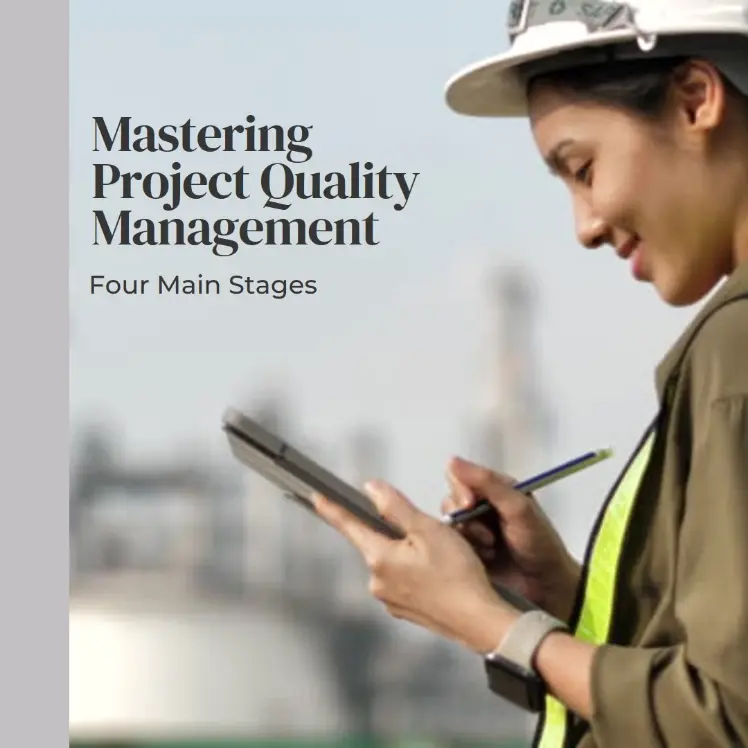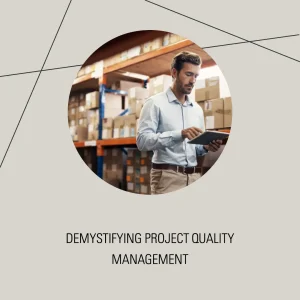I. Introduction
Hello, fellow project management enthusiasts! In today’s fast-paced and competitive business environment, delivering high-quality projects is more critical than ever. As a project manager, you’re responsible for making sure that your projects not only meet but also exceed customer expectations. Achieving this level of success is no easy task, but fear not, I’m here to help! In this blog post, we will explore the four main stages of project quality management, which, when mastered, can significantly improve the chances of your project’s success.
The four main stages we will delve into are planning, assurance, control, and continuous improvement. Each stage plays a crucial role in ensuring that your project remains on track, adheres to quality standards, and ultimately delivers a product or service that leaves your customers thrilled. Now, let’s briefly touch on what you can expect from each stage before diving deeper into each one in the subsequent sections.
- Planning: In this initial stage, we’ll focus on defining the project’s quality requirements and developing a comprehensive quality management plan. The goal here is to set clear expectations and establish a solid foundation for the rest of the project.
- Assurance: Next up, we’ll dive into the assurance stage, where we’ll concentrate on monitoring the project’s processes, conducting quality audits, and taking corrective actions as needed. This stage helps ensure that your project is adhering to the established quality standards and guidelines.
- Control: During the control stage, we’ll keep a close eye on project quality metrics and implement change control processes. This stage is all about tracking progress, managing changes, and adapting project plans to maintain quality standards.
- Continuous Improvement: Last but certainly not least, we’ll focus on the continuous improvement stage. Here, we’ll analyze project performance, implement lessons learned, and foster a culture of continuous improvement within the team. This stage ensures that your project, and future projects, continually improve and adapt to meet the ever-changing needs of your customers.
I’m excited to embark on this journey with you to master the four main stages of project quality management. By understanding and implementing these principles in your projects, you’ll be better equipped to navigate the challenges that inevitably arise and ultimately deliver outstanding results that leave your customers delighted. So, buckle up and let’s get started!
II. Stage 1: Planning A. Defining project quality requirements
Welcome back, project management aficionados! As we begin our deep dive into the four main stages of project quality management, let’s kick things off with the crucial first stage: planning. In this section, we’ll explore how to define project quality requirements, develop a quality management plan, and create a quality assurance process. Remember, a well-planned project sets the stage for success, so let’s get started!
A. Defining Project Quality Requirements
- Identifying Customer Expectations: The first step in planning for quality is understanding what your customers expect. Initiate open and honest conversations with your stakeholders to gain a clear understanding of their needs, preferences, and expectations. Be sure to ask specific questions and encourage feedback, as this will enable you to develop a detailed understanding of what they consider high quality.
- Aligning Project Goals with Organizational Objectives: After getting a grasp on customer expectations, it’s essential to align your project goals with the overarching objectives of your organization. This ensures that your project not only meets customer needs but also contributes to the success of the company as a whole.
B. Developing a Quality Management Plan
- Establishing Quality Objectives: With your project goals aligned and customer expectations in mind, it’s time to establish clear and measurable quality objectives. These objectives should serve as a roadmap to achieving the desired level of quality and should be SMART (Specific, Measurable, Achievable, Relevant, and Time-bound).
- Selecting Appropriate Quality Standards and Methodologies: Now, choose the quality standards and methodologies that best align with your project’s objectives and industry requirements. Familiarize yourself with these standards, as they will provide a framework for measuring project quality and ensuring that your team adheres to best practices.
C. Creating a Quality Assurance Process
- Assigning Roles and Responsibilities: A well-structured quality assurance process involves assigning specific roles and responsibilities to team members. This could include a designated quality manager, quality control team, or even incorporating quality-related tasks into the roles of existing team members. Clearly defining these responsibilities ensures that everyone knows what’s expected of them when it comes to maintaining project quality.
- Setting up a Quality Audit Schedule: Finally, establish a schedule for conducting regular quality audits throughout the project lifecycle. These audits will allow you to monitor your team’s adherence to established quality standards, identify any areas of non-compliance, and take corrective actions as needed.
And there you have it! By focusing on defining project quality requirements, developing a comprehensive quality management plan, and creating a robust quality assurance process, you’re setting the stage for a successful project. In the next section, we’ll dive into the assurance stage, where we’ll learn how to monitor project processes, conduct quality audits, and take corrective actions to ensure your project remains on track. See you there!
III Stage 2 – Assurance
Hello again, project management enthusiasts! After laying the foundation for project success in the planning stage, it’s time to move on to the assurance stage. In this section, we’ll discuss monitoring project processes, conducting quality audits, and taking corrective actions. Let’s dive in and make sure your project stays on the path to greatness!
A. Monitoring Project Processes
- Implementing Quality Control Measures: In order to ensure that your project is adhering to the quality standards you’ve established, it’s crucial to implement quality control measures. This involves closely monitoring the work being done and checking it against the established quality objectives. Make use of tools like checklists, templates, and standardized processes to keep everyone on the same page and ensure a consistent approach to quality.
- Ensuring Compliance with Quality Standards: As you monitor your project’s progress, be sure to keep an eye on compliance with the quality standards you’ve selected. This involves regularly reviewing project documentation, deliverables, and other work products to verify that they meet the necessary criteria.
B. Conducting Quality Audits
- Identifying Areas of Non-compliance: Quality audits serve as a fantastic tool for identifying areas where your project may not be meeting established quality standards. Schedule these audits at regular intervals throughout the project lifecycle, and be prepared to evaluate everything from processes and documentation to team performance and deliverables.
- Assessing the Effectiveness of Quality Management Processes: In addition to identifying areas of non-compliance, quality audits also provide an opportunity to assess the effectiveness of your quality management processes. Use the insights gained from these audits to make data-driven decisions about potential adjustments or improvements to your quality management plan.
C. Taking Corrective Actions
- Addressing Identified Issues: Once you’ve identified areas of non-compliance or opportunities for improvement, it’s essential to take prompt corrective action. This may involve revising processes, providing additional training, or reallocating resources to address the issues at hand. Remember, the sooner you address these concerns, the better positioned your project will be for success.
- Continuously Improving Project Quality: As you implement corrective actions, don’t forget to keep an eye on the bigger picture. Strive for continuous improvement by regularly reviewing your project’s performance and seeking out opportunities to enhance quality even further.
By focusing on monitoring project processes, conducting quality audits, and taking corrective actions, you’re well on your way to ensuring your project meets and exceeds the high-quality standards you’ve set. Next up, we’ll explore the control stage, where we’ll discuss tracking project quality metrics and implementing change control processes. Stay tuned for more project management insights!
IV Stage 3 – Control
Hello, project management mavens! With a solid foundation in the planning and assurance stages, it’s time to tackle the control stage. In this section, we’ll explore tracking project quality metrics, implementing change control processes, and adapting project plans to maintain quality standards. Let’s jump in and keep your project on track for success!
A. Tracking Project Quality Metrics
- Defining Key Performance Indicators (KPIs): To effectively monitor your project’s quality, it’s essential to establish a set of key performance indicators (KPIs). These are measurable values that help you track progress toward your quality objectives. When selecting KPIs, consider factors such as customer satisfaction, defect rates, and process efficiency. By monitoring these KPIs, you’ll be better equipped to identify trends and make data-driven decisions about your project’s quality.
- Monitoring Project Progress Against KPIs: With your KPIs defined, make it a priority to consistently monitor project progress against these metrics. Set up regular check-ins with your team to review the latest data and discuss any potential issues or concerns. This proactive approach to monitoring will help you identify and address quality issues before they escalate.
B. Implementing Change Control Processes
- Reviewing and Approving Change Requests: Inevitably, changes will arise throughout the course of your project. To maintain control over project quality, it’s crucial to implement a robust change control process. This involves reviewing and approving change requests, ensuring they align with your project’s quality objectives and assessing their potential impact on the project.
- Managing the Impact of Changes on Project Quality: Once a change request is approved, take the necessary steps to manage its impact on project quality. This may involve updating project documentation, adjusting processes, or reallocating resources as needed. By effectively managing change, you’ll be better positioned to maintain the high-quality standards you’ve established for your project.
C. Adapting Project Plans and Processes
- Making Necessary Adjustments to Maintain Quality Standards: As your project progresses and changes arise, it’s essential to adapt your project plans and processes accordingly. This may involve revising your quality management plan, refining your quality control measures, or updating your project schedule. By staying agile and adaptable, you’ll ensure that your project remains aligned with customer expectations and quality standards.
- Ensuring Continued Alignment with Customer Expectations: Regularly check in with your customers and stakeholders to ensure that your project remains aligned with their expectations. Be open to their feedback and make any necessary adjustments to maintain the desired level of quality.
By focusing on tracking project quality metrics, implementing change control processes, and adapting project plans, you’ll be well-equipped to maintain control over project quality. In the final stage of our journey, we’ll discuss continuous improvement and how to analyze project performance, implement lessons learned, and foster a culture of improvement. See you in the next section!
V Stage 4 – Continuous Improvement
Welcome back, project management gurus! We’ve made it to the final stage of our journey: continuous improvement. In this section, we’ll discuss analyzing project performance, implementing lessons learned, and fostering a culture of continuous improvement within your team. Let’s dive in and finish strong!
A. Analyzing Project Performance
- Identifying Trends and Patterns in Quality Metrics: As your project progresses, it’s crucial to analyze your quality metrics to identify trends and patterns. By regularly examining these metrics, you can spot potential issues before they become significant problems and identify opportunities to enhance project quality even further.
- Evaluating the Success of Quality Management Strategies: In addition to analyzing your quality metrics, take the time to evaluate the overall success of your quality management strategies. Reflect on which approaches have been most effective in achieving your quality objectives and consider any areas where adjustments may be necessary.
B. Implementing Lessons Learned
- Sharing Best Practices Across the Organization: One of the most valuable aspects of continuous improvement is the ability to share lessons learned and best practices with other teams and projects within your organization. By doing so, you’ll help to create a culture of continuous improvement that benefits everyone.
- Incorporating Feedback into Future Projects: As your project wraps up, gather feedback from your team, customers, and stakeholders on what went well and what could be improved. Use this feedback to refine your quality management approach and incorporate these lessons into your future projects.
C. Fostering a Culture of Continuous Improvement
- Encouraging Open Communication and Collaboration: A culture of continuous improvement thrives on open communication and collaboration. Encourage your team to share their ideas, concerns, and suggestions for improvement. By fostering an environment where everyone feels comfortable contributing, you’ll empower your team to take ownership of the project’s quality.
- Empowering Team Members to Contribute to Quality Improvement Efforts: Empower your team members to actively contribute to quality improvement efforts by providing them with the tools, resources, and support they need to make a difference. Recognize and reward their efforts, and celebrate the successes achieved through their hard work and dedication.
And that’s a wrap! By focusing on continuous improvement, you’ll ensure that your project, and future projects, continually adapt and evolve to meet the ever-changing needs of your customers. With the four main stages of project quality management under your belt, you’re now well-equipped to tackle any project with confidence and achieve outstanding results. Happy project managing!
Vi Conclusion and Next Steps
Congratulations, project management aficionados! You’ve successfully explored the four main stages of project quality management: planning, assurance, control, and continuous improvement. By now, you should have a solid understanding of how to navigate these stages to achieve exceptional project outcomes. But don’t stop here! In this concluding section, we’ll discuss some next steps to ensure that you continue to excel in project quality management.
A. Apply Your Knowledge to Real-Life Projects
The best way to reinforce your understanding of project quality management is to apply these principles to your own projects. Start by reviewing your current projects and identifying areas where you can incorporate the strategies you’ve learned. As you gain experience, you’ll become increasingly adept at managing project quality and achieving success.
B. Keep Learning and Stay Updated
The world of project management is constantly evolving, and staying up-to-date with the latest trends and best practices is essential for continued success. Seek out opportunities to expand your knowledge by attending workshops, conferences, and webinars, as well as by connecting with other project management professionals. This will help you stay current with the latest industry developments and ensure that your skills remain sharp and relevant.
C. Obtain Project Management Certifications
Consider pursuing project management certifications, such as the Project Management Professional (PMP) or PRINCE2, to validate your expertise and demonstrate your commitment to excellence in project quality management. These certifications can help you stand out from the competition and open doors to new opportunities.
D. Foster a Quality-Driven Culture within Your Organization
Last but certainly not least, work towards fostering a quality-driven culture within your organization. Share your knowledge with colleagues, promote open communication and collaboration, and lead by example. By doing so, you’ll create an environment where everyone is focused on delivering high-quality projects that delight customers and drive success.
Once again, congratulations on completing this exploration of the four main stages of project quality management! By understanding and implementing these principles in your projects, you’ll be well-prepared to tackle any challenge that comes your way and ultimately deliver outstanding results that leave your customers delighted. Best of luck on your project management journey, and remember – the sky’s the limit!
To find out how Artificial Intelligence is changing the Project Management landscape, you have enjoy reading this article https://www.shaunstoltz.com/did-artificial-intelligence-just-change-everything-about-project-management/
Find out more about Shaun Stoltz https://www.shaunstoltz.com/about/
This post was written by an AI and reviewed/edited by a human.



